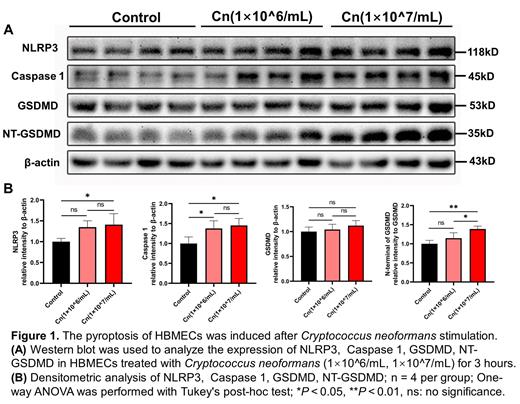Background:
Cryptococcus neoformans (Cn) traversal of the blood-brain barrier (BBB), composed of human brain microvascular endothelial cells (HBMECs), is a critical process in central nervous system infection. Previous studies have achieved significant progress in pathogenic mechanisms how Cn penetrates BBB. However, it is still largely elusive about the cellular and molecular mechanism of the abrasive interaction between Cn and HBMECs. Here, we focus on the pathogenesis of direct damage to the HBMECs by Cn.
Methods:
The immortalized HBMECs were incubated with Cryptococcus neoformans strain B-4500FO2 in different final concentrations (1×10^6/mL, 1×10^7/mL) for 3 hours at 37℃. The control group was treated with isovolumic phosphate buffered saline. Then, total soluble proteins of HBMECs in each group were extracted with RIPA lysis buffer for immunoblotting analysis. ImageJ and SPSS software were used for grayscale and statistical analysis respectively.
Results:
We found that the expression levels of pyroptosis-related protein, including NLRP3, Caspase 1, N-terminal of GSDMD especially, were significantly upregulated in HBMECs treated with higher concentrations (1×10^7/mL) of Cn compared to control group ( P < 0.05), in spite of the fact that there was no statistically significant difference in the expression of GSDMD ( P > 0.05).
Conclusion:
These data support that Cn might impair BBB through facilitating pyroptosis of HBMECs via NLRP3/Caspase 1/GSDMD signaling. More intensive investigations are still required to elucidate the underlying mechanism how pyroptosis is triggered and transmitted in the interaction between Cn and HBMECs.
( Acknowledgements: Undergraduate Training Program for Innovation and Entrepreneurship of SMU, China, No. 202312121330; Corresponding author: Hong Cao, gzhcao@smu.edu.cn )
Disclosures
No relevant conflicts of interest to declare.


This feature is available to Subscribers Only
Sign In or Create an Account Close Modal